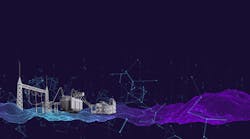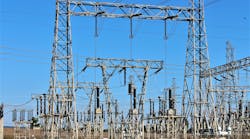Does it seem like the power delivery system is always in the process of some type of transition? It’s almost a transitions-R-us situation, but in all fairness, it’s a little more complicated than that. This all started out with the goal of modernizing the grid and digital technology is the key to any modernization effort. Once digitalization is recognized as the driving force, it’s easy to see why there has been one series of transitions after another. Modernization goes hand in hand with digitalization, but no one foresaw how far reaching this effort would be.
The modern power grid transition may have started off small, but it didn’t stay that way for long. One of the first digital technologies introduced was the semi-smart electric meter. They matured into the advanced metering infrastructure (AMI). AMI took advantage of wireless communications, which brought about the two-way metering. That in turn encourage distributed energy resources on the customer’s side of the meter and that’s only one example.
This transitional listing is a long one and growing longer every day. Each step further into the digital changeover sets us up for the next transition and the next. There are so many interrelated transitions let’s keep it simple by concentrating on one grid element.
Substation Transition
The electrical substation has benefited from transitional changes over the years, but in recent years digital technology seems to have accelerated the process. It started in the control building. The first step toward the digital substation was the protection, control, and communication applications. Real progress happened when the substation yard equipment began digitizing. With the control building setup to handle big-data, suppliers began providing add-on sensors and monitors for the existing outdoor devices. It proved to be a valuable addition that led to the next level.
Manufacturers such as GE, Hitachi Energy, Eaton, Siemens Energy, Mitsubishi, Schneider Electric, and others provided sensors, actuators, and monitoring systems built directly into the apparatuses at the factory. That step turned the equipment into fully functioning, intelligent electronic devices (IEDs). With the IEDs generating data it was time for the replacement of the copper control cables. Fiber optic cables did a better job of connecting the control building and IEDs when it came to big-data. That upgrade enabled the substation to take advantage of all the benefits the industrial internet of things (IIoT) had to offer. Another transition was underway.
GE Digital reported that ”By combining machine-to-machine communication with industrial data analytics, IIoT is driving unprecedented levels of efficiency, productivity, and performance.” The real-time data provided by the IEDs offered better visibility of the power delivery network, which was an improvement for operational technology (OT). OT is an asset-oriented application that has proven to be a handy digital tool for the utility’s toolbox.
Cloud Connectivity
It’s all about device connectivity, and device-to-device links led the way to direct device-to-computer networks. This IIoT connectivity brought information technology (IT) into the substation, which allowed the substation to transition into the IT/OT convergence, That opened the door to improved substation automation not to mention operational enhancements.
Siemens Energy took advantage of this transition with their Sensproducts product line. That resulted in moving advanced asset management systems into another level. For the complete story see “The Bits and Pieces Are Getting Smarter” in the November 2020 (https://tdworld.com/21143157) T&D World.
Technologies never stand still. They either advance and mature or they drop by the wayside. That is one of the aspects of the digitalization of the power grid that is truly fascinating. In the case of Sensproducts all indications point toward advancement. According to Siemens Energy, the Sensproducts applications are taking advantage of the latest technological developments with cloud connectivity, real-time, big-data analytics, artificial intelligence, digital twin technology, and cyber-security. Siemens Energy pointed out that since the introduction of Sensproducts, continuous improvement processes have taken place.
The Casa dos Ventos’ onshore Rio do Vento windfarm in Brazil is a good example. The windfarm will have 240 wind turbines with an installed capacity of 1,038 megawatts and its substation has two Siemens Energy Sensformers. They were energized in late 2021 and are connected to secure online platform where the owner can access real-time information and utilize digital twin intelligence.
Charging Ahead talked with Eduardo Terzi, Siemens Energy’s Senior Vice-President for Non-Switching Products about the windfarm and the Sensformer technology.
Charging Ahead: How do the Sensformers improve windfarms?
Terzi: “When we talk about Sensformers, we mean transformers equipped with additional sensors and digitally connected. Various digital applications offer customers the opportunity to monitor the status of the corresponding transformers precisely to optimize operations. In wind power generation, Sensformers can be used as step-up transformers directly in the tower, or in the nacelle, on offshore platforms, or in the substations on land. In all cases, Sensformers increase transparency, reliability, and operational safety.”
Terzi explained, “Moreover, OPEX [operating expenses] can be decreased by condition based maintenance, and time-limited overload operations can be realized, without negative impacts on transformer lifetime. Operators of wind farms and connected substations benefit in particular from the use of Sensformers because the additional information gained makes it easier to manage the fluctuating power in-feeds. The cycling operation scheme of the wind generator results in non-conventional transformer load profiles, and therefore real-time observation and status analysis are especially important. Sensformers can recognize impending overheating by measuring oil temperatures and winding currents, and sending the results to the cloud. The information provided turns the transformers into information hubs that allow wind energy to be used in the most efficient way possible.”
Charging Ahead: How do digital twins play a part here?
Terzi: “Sensformer Advanced is based on a digital twin. The digital twin is a virtual replication of each single transformer, reflecting the specific design data of the transformer. This computational duplication is based on operational data like winding currents, cooling equipment status and ambient temperatures – either in real time to produce an online simulation, or even in advance to simulate potential transformer operation states.”
Terzi continued, “The digital twin provides an accurate and complete thermal image of a transformer, and is the basis for calculating, for example, overload capabilities, maintenance needs, and critical operational states. The digital twin is the only way to allow temporary overload operations during periods of very high wind energy infeed without increasing the risk of failure. In future, Sensformer Advanced will also help to monitor moisture within the transformer. This will be an important new feature for wind applications since cycling loads result in permanent moisture diffusion within the transformer’s insulation.”
Advanced Asset Management
The development and deployment of digital twin technologies greatly reduces the complexity of the technologies for the customer, by improving its user friendliness. Late last year, Hitachi Energy announced it had launched IdentiQ. It’s a hybrid cloud digital twin application for HVDC (high-voltage direct current) converter stations, STATCOM (static synchronous compensator) or other power quality devices. The IdentiQ system provides a 3D virtual representation of the physical asset. This 3D model is an interactive visualization of the complete HVDC or STATCOM facility with all the relevant asset information, analytics, and operational data.
Hitachi explained that the system also includes all the associated plant and equipment information, including engineering documentation, operational and maintenance procedures, safety training and live operational data for monitoring and analytics. It can also adapt to cybersecurity performance requirements with ease of updating as requirements change. Anyone who has worked in an HVDC converter station can appreciate having a user friendly dashboard assisting them in understanding what is taking place.
Utilities are really taking advantage of this transitional technology and have recently declared plans for utilizing digital twin system models. In Tasmania, TasNetworks announced the development a digital twin of their distribution network. In the United Kingdom, National Grid ESO said it will create a digital twin of the entire island’s power network. Singapore is developing a digital twin of their network to improve reliability. Tensio, the Norwegian distribution system operator is evaluating Kognitwin Grid’s digital twin application and the list keeps growing.
Digital technology transitions are having an enormous influence on the transmission and distribution grids and it’s happening on a global scale. According to a recent study by Global Market Insights, the digital substation market exceeded US$ 6.5 billion in 2021. They anticipate that to grow to over US$ 10.5 billion by 2028. What was really surprising was a research report by Markets and Markets specifically on digital twin technology in the power delivery industry. They reported that US$ 0.8 billion in 2021 was spent on digital twin technology for the power grid, and projected the market will reach US$ 1.3 billion by 2026.
The global transition to a digitalized power grid is progressing faster than anticipated. Applications like intelligent substations and digital twins are changing the grid’s architecture making it more flexible. These elements are now self-aware and self-managed. Transitions are definitely trending!


